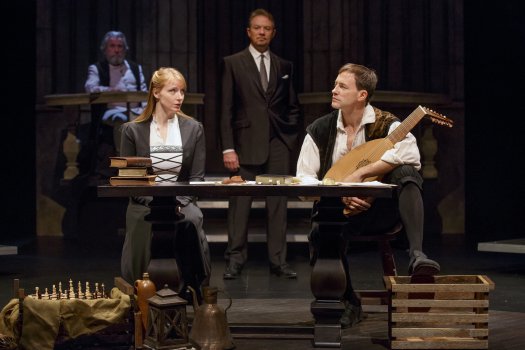Martin Luther on Trial
In the 500th year since the Protestant Reformation, fascinating new play puts Hitler, Freud, Martin Luther King, Jr., and Pope Francis on the witness stand.

John Michalski, Kersti Bryan, Paul Schoeffler and Fletcher McTaggart in a scene from “Martin Luther on Trial” (Photo credit: Joan Marcus)
[avatar user=”Victor Gluck” size=”96″ align=”left” ] Victor Gluck, Editor-in-Chief[/avatar]In the 500th year since the 95 Theses and the resulting Protestant Reformation, Martin Luther on Trial, a fascinating new play by Chris Cragin-Day and Max McLean, puts Adolph Hitler, Sigmund Freud, Martin Luther King, Jr. and Pope Francis on the witness stand. The first wholly original play to be produced by Fellowship for the Performing Arts (FPA), Martin Luther on Trial directed by Michael Parva with a versatile and accomplished cast of six is a play of ideas which theatricalizes its concepts and theories. It would take theologians and philosophers to decide whether the play is accurate to historical fact but the results on the stage of The Pearl Theatre are absorbing and compelling.
Set in The Afterlife, a crossroad between Heaven and Hell, the play presupposes a trial of Luther on the grounds of being guilty of “the unforgiveable sin.” The prosecuting attorney is The Devil and the defending attorney is Katie von Bora, also known as Mrs. Martin Luther, with Saint Peter acting as judge. The witnesses called are Hitler on Luther’s anti-Semitism in his later years, Dr. King on Luther’s stance on civil rights, Dr. Freud on Luther’s Oedipus complex, and the current Pope on the Catholic Church’s stance on Luther’s objections today. Along the way, the play also dramatized scenes from Luther’s life. Ultimately, it ends with a recreation of Luther’s trial before the Diet of Worms officiated over by the Holy Roman Emperor in 1521.

Fletcher McTaggart in the title role of “Martin Luther on Trial” (Photo credit: Joan Marcus)
The play’s first act is more focused and successful than the second. Not only does the second act bring in a slew of additional witnesses for brief statements of their opinion, it seems to lose its focus on the purpose of the trial with more and more scenes from Luther’s life. However, it remains dramatic and engrossing throughout even though the ideas become a little bit hard to follow. The play does not avoid Luther’s difficult later years when he became violent and anti-Semitic partly due to his anger over how things were developing in Germany. One of the more important points made is that by translating the Bible into German, Luther unified the many dialects of the language and ultimately the country.
Parva’s deft staging makes use of five playing areas in Kelly James Tighe’s unit set, which makes for swift transitions between the many scenes and flashbacks. The cast is uniformly adept with two actors demonstrating their skills playing many roles. Paul Schoeffler is a very dapper, urbane Devil, while Kersti Bryan’s Katie von Bora is most impassioned. As Martin Luther, Fletcher McTaggart is a very complex thinker with streaks of aggression and choler. Mark Boyett’s five roles are a study in contrasts from an egotistical Hitler to a slippery Freud to an effacing Pope Francis. In his role as judge, John Michalski’s St. Peter is suave and courtly. Playing six roles, Jamil A.C. Mangan is particularly fine as Martin Luther King, Jr., and makes each role very different.

Kersti Bryan as Katie Von Bora and Paul Schoeffler as The Devil in a scene from “Martin Luther on Trial” (Photo credit: Joan Marcus)
Nicole Wee’s costumes run the gamut from medieval clothes, to contemporary suits and uniforms to otherworldly religious outfits. Geoffrey D. Fishburn’s subtle lighting always directs attention to the proper location on the multi-tiered unit set. Quentin Chiappetta is responsible for the elegant piano music which punctuates the scenes.
Martin Luther on Trial is a fascinating investigation of the life and ideas of the founder of the Protestant Reformation. Whatever your religious beliefs, this is a balanced and theatrical representation of one of the great thinkers and shakers of Western Civilization. It is timely in that 2017 is the 500th anniversary of Luther’s break from Rome.
Martin Luther on Trial (through January 29, 2017)
Fellowship for the Performing Arts
The Pearl Theatre, 555 W. 42nd Street, in Manhattan
For tickets call 212-563-9261 or visit http://www.FPAtheatre.com
Running time: two hours and five minutes with one intermission






Leave a comment